Tenkara Fishing and Tying |
 |
| Tenkara fishing is important to read the water and recognize good lies than to be particular about tackle. |
Cast and Distance
|
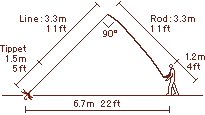 |
|
| The tenkara fisher swings or cast the line so that the angle between rod and line is approximately 90 degrees.
If rod and line are each about 3.3m (11ft.) long, the fly would be fishing about 6.7m (22ft.) out,
but the length of line is changed by scale of streams and skil of anglers.
That cast is almost same western fly fishing, but those cast of tenkara and western fly fishing are different
in respect to use wrist snap. |
||
Rod Manipulation to Work the Fly
|
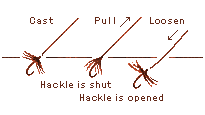 |
|
| The fly action is transformed tenkara fly to attractive bait and
it is sharpend a trout's appetite.
This figure is one instance of rod manipulation to work the flies.
We usually use tenkara fly in the upper current or surfase, so
we don't sink tenkara line into current. We sink only tipet into current.
Even we sometimes use tenkara fly in the middle or bottom current as if it is nymph fly. |
||
Cast for Showing off the Fly "Sutebari"
|
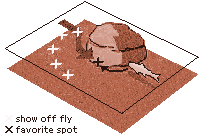 |
|
| One tenkara technique worth mentioning is called "Sutebari" that showing off the fly.
If Sutebari is trans- lated word for word, it is "throw away fly".
We often use this technique that hit on the surface around the favorite spot a few times,
before it cast to the favorite spot saddenly.
When Trout paid attention to surface well, we cast final fly to "favorite spot"
and get ready for the strike.
Using tenkara flies and techniques, we can seduce trout and many other species everywhere.
|
||
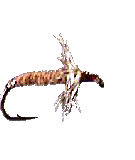 |
Tying of Typical Tenkara with Kenbane of pheasant
| |
| 1. | Use a size 7-9 Tenkara hook (10-14 Mustad 94840 or 3399A, TMC 101 or 531, slightly wide gap dry fly hook).
Attach the tying thread at a point 2 eye width back from the eye of the hook. |
|
| 2. | Tie in a gold tinsel and wrap the thread back to a point directly opposite the point of the barb. |
|
| 3. | Wind the gold tinsel foward, each turn to overlap the previous one,
and the tying thread back to the point of the barb. |
|
| 4. | Leave a tag of gold tinsel, wrap a cotton of flowering fern
and overlap the tying thread to eye. |
|
| 5. | Tie the tip of a half kenbane (alula) of pheasant or copper pheasant to the hook, make the hackle and coat with the head cement. |
|
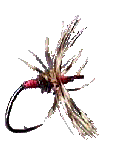 |
Tying of Reversed Hackle Fly "Sakasa-Kebari"
|
|
| 1. | Use a size 8 Japanese bait hook (10-12 TMC 206BL, similar short shank wide gap hook),
form a 2mm (1/12in.) eye loop by whipping braided backing line to the shank and coat with the head cement. |
|
| 2. | Tie in a head with the silk thread about 1.5mm (3/5in.) and tie in the tip of one pheasant hackle to the
hook shank, at the back of head. |
|
| 3. | Wind the hackle (turn the reverse side to front) and tie off.
With thumb and forfinger, pull the hackle foward and tie the base of the hackle
for keep slants of the hackle. |
|
| 4. | Tie the thorackse with a peacock herl, 1/2 of the body. |
|
| 5. | Tie the silk thread from the solax to the hook bend several times, and coat the end with the head cement. | |
|
References: Fuji, H. (1990). Gendai Tenkara. Osaka: Weekly Sunday Fishing. Ishigaki, H. (1992). Kagaku suru Kebari tsuri [Science of Kebari fishing]. Tokyo: Kosaido Publishing. Kuwabara, H., Sugimoto, H., & Takasaki, T. (1966). Keiryu no Tsuri [Mountain stream Fishing]. Tokyo: Tsuribitosha. Yamamoto, S. (1973). Nishinihon no Yamazuri [Mountain Fishing in Western Japan]. Osaka: Tsurinotomosha. |
||
Flies |
Equipment |
| Back to Main Home Page | Profile | Links |
Home |
Paper Craft of Japanese Trout and the World Trout © 1997 Yoshikazu Fujioka |